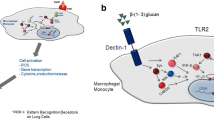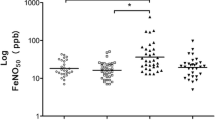Abstract
Objective
We examined the risk factors for the development of airway allergy in animal shelter workers.
Methods
The study population comprised 88 animal shelter workers occupationally exposed to cats and dogs. They responded to a questionnaire concerning the history of exposure to animal allergens and job characteristics and were subjected to skin prick test (SPT) to common and occupational allergens (cat and dog), and determination of total serum IgE level and specific IgE. In addition, SPT with rat and mouse allergens were performed. Bronchial hyperreactivity and peak expiratory flow rate were measured at work and off work only in workers with work-related symptoms suggestive of occupational asthma (OA).
Results
The prevalence of OA was 9.1%. Sensitization to dog allergens was higher than to cats. The multivariate logistic regression analysis revealed a significant role of positive family history of atopy and having a dog as pet in the past for the development of occupational airway allergy (OR 5.9; 95% CI 1.76, 20.00; P = 0.003; OR 6.47; 95% CI 1.90, 22.02; P = 0.002, respectively). In the multivariate logistic regression analysis, the risk for developing OA was most clearly associated with growing up in the country (OR 7.59; 95% CI 1.25, 45.9; P = 0.025).
Conclusions
Allergic disease is a serious occupational health concern for subjects who have occupational contact with cats and dogs.


Similar content being viewed by others
Abbreviations
- SPT:
-
Skin prick test
- OAA:
-
Occupational airway allergy
- PEFR:
-
Peak expiratory flow rate
- BHR:
-
Bronchial hyperreactivity
- OA:
-
Occupational asthma
References
Agrup G, Belin I, Sjostedt L, Skerfving S (1986) Allergy to laboratory animals in laboratory technicians and animal keepers. Br J Ind Med 43:192–198
Aoyama K, Ueda A, Manda F, Matsushita T, Ueda T (1992) Allergy to laboratory animals: an epidemiological study. Br J Ind Med 49:41–47
Burney PG, Laitinen LA, Perdrizet S, Huckauf H, Tattersfield AE, Chinn S, Poisson N, Heeren A, Britton JR, Jones T (1989) Validity and repeatability of the IUATLD (1984) Bronchial Symptoms Questionnaire: an international comparison. Eur Respir J 2:940–945
Botham PA, Davies GE, Teasdale EL (1987) Allergy to laboratory animals: a prospective study of its incidence and of the influence of atopy on its development. Br J Ind Med 44:627–632
Cockcroft DW, Killian DN, Mellon JJ, Hargreave FE (1977) Bronchial reactivity to inhaled histamine: a method and clinical survey. Clin Allergy 7:235–243
Cote J, Kennedy S, Chan-Yeung M (1990) Sensitivity and specificity of PC20 and peak expiratory flow rate in cedar asthma. J Allergy Clin Immunol 85:592–598
Cullinan P, Cook A, Gordon S, Nieuwenhuijsen MJ, Tee RD, Venables KM, McDonald JC, Taylor AJ (1999) Allergen exposure, atopy and smoking as determinants of allergy to rats in a cohort of laboratory employees. Eur Respir J 13:1139–1143
Dabbagh K, Dahl ME, Stepick-Biek P, Lewis DB (2002) Toll-like receptor 4 is required for optimal development of Th2 immune response: role of dendritic cells. J Immunol 168:4524–4530
Dreborg S, Frew AJ (1993) Allergen standarisation and skin tests. Allergy 47:S48–S82
Eder W, Klimecki W, Lizhi Y, von Mutius E, Riedler J, Braun-Fahrlander Ch, Nowak D, Martinez FD (2004) Toll-like receptor 2 as a major gene for asthma in children of European farmers. J Allergy Clin Immunol 113:482–488
Eisenbarth SC, Piggott DA, Huleatt JW, Visintin I, Herrick CA, Bottomly K (2002) Lipopolysasccharide-enhanced, toll-like receptor 4-dependent T helper cell type 2 responses to inhaled antigen. J Exp Med 196:1645–1651
Elliott L, Heederik D, Marshall S, Peden D, Loomis D (2005) Progression of self-reported symptoms in laboratory animal allergy. J Allergy Clin Immunol 116:127–132
Haahtela T, Jaakonmaki I (1981) Relationship of allergen-specific IgE antibodies, skin prick tests and allergic disorders in unselected adolescents. Allergy 36:251–256
Heederik D, Venables KM, Malmberg P, Hollander A, Karlsson AS, Renström A, Doekes G, Nieuwenhuijsen M, Gordon S (1999) Exposure-response relationships for work-related sensitization in workers exposed to rat urinary allergens: results from a pooled study. J Allergy Clin Immunol 103:678–684
Heinrich J, Gehring U, Douwes J, Koch A, Fahlbusch B, Bischof W, Wichmann HE (2001) Pets and vermin are associated with high endotoxin levels in house dust. Am J Respir Crit Care Med 163:A844
Hesselmar B, Äberg N, Äberg B, Eriksson B, Björksten B (1999) Does early exposure to cat or dog protect against later allergy development ? Clin Exp Allergy 29:611–617
Hollander A, Doekes G, Heederik D (1996) Cat and dog allergy and total IgE as risk factors of laboratory animal allergy. J Allergy Clin Immunol 98:545–554
Hölscher B, Frye C, Wichmann HE, Heinrich J (2002) Exposure to pets and allergies in children. Pediatr Allergy Immunol 13:334–341
Holt PG, O’Keeffe PO, Holt BJ, Upham JW, Baron-Hay MJ, Suphioglu C, Knox B, Stewart GA, Thomas WR, Sly PD (1995) T-cell “priming” against environmental allergens in human neonates: sequential deletion of food antigens reactivity during infancy with concomitant expansion of responses to ubiquitous inhalant allergens. Pediatric Allergy Immunol 6:85–90
Hunskaar S, Fosse RT (1990) Allergy to laboratory mice and rats: a review of the pathophysiology, epidemiology and clinical aspects. Lab Anim 24:358–374
Hunter CJ, Brightling CE, Woltmann G, Wardlaw AJ, Pavord ID (2002) A comparison of the validity of different diagnostic tests in adults with asthma. Chest 121:1051–1057
Imler JL, Hoffmann JA (2001) Toll receptors in innate immunity. Trends Cell Biol 11:304–311
Jagielo PJ, Thorne PS, Watt JL, Frees KL, Quinn TJ, Schwartz DA (1996) Grain dust and endotoxin inhalation challenges produce similar inflammatory responses in normal subjects. Chest 110:263–270
Johansson SG, Hourihane JO, Bousquet J, Bruijnzeel-Koomen C, Dreborg S, Haahtela T, Kowalski ML, Mygind N, Ring J, van Cauwenberge P, van Hage-Hamsten M, Wuthrich B. (2001) A revised nomenclature for allergy. An EAACI position statement from the EAACI nomenclature task force. Allergy 56:813–824. Review. Erratum in: Allergy 2001 Dec; 56(12):1229
Johnson CC, Chan-Yeung M (1999) Nonspecific bronchial hyperresponsiveness. In: Bernstein IL, Chan-Yeung M, Malo JL, Bernstein DI (eds) Asthma in the workplace. Marcel Dekker, Basel, pp 173–210
Johnson CC, Alford SH (2002) Do animals on the farm and in the home reduce the risk of pediatric atopy? Curr Opin Allergy Clin Immunol 2:133–139
Lindfors A, van Hage-Hamsten M, Rietz H, Wickman M, Nordvall SL (1999) Influence of interaction of environmental risk factors and sensitization in young asthmatic children. J Allergy Clin Immunol 104:755–762
Linnenberg A, Nielsen NH, Madsen F, Fröund L, Dirksen A, Jörgensen T (2003) Pets in the home and the development of pet allergy in adulthood. The Copenhagen Allergy Study. Allergy 58:21–26
Malolepszy J, Liebhart J, Wojtyniak B, Pisiewicz K, Plusa T (2000) Prevalence of allergic diseases in Poland. Alergia Astma Immunologia 5:163–169 (in Polish)
Pacheco KA, McCammon Ch, Liu AH, Thorne PS, O’Neill ME, Martyny J, Newman LS, Hamman F, Rose SC (2003) Airborne endotoxin predicts symptoms in non-mouse-sensitized technicians and research scientists exposed to laboratory mice. Am J Respir Crit Care Med 167:983–990
Perrin B, Lagier F, L’Archeveque J, Cartier A, Boulet LP, Cote J, Malo JL (1992) Occupational asthma: validity of monitoring of peak expiratory flow rates and non-allergic bronchial responsiveness as compared to specific inhalation challenge. Eur Respir J 5:40–48
Platts-Mills T, Vaughan J, Squillace S, Woodfolk J, Sporik R (2001) Sensitisation, asthma, and modified Th2 response in children exposed to cat allergen: a population-based cross-sectional study. Lancet 357:752–756
Quirce S, Contreras G, Dybuncio A, Chan-Yeung M (1995) Peak expiratory flow monitoring is not a reliable method for establishing the diagnosis of occupational asthma. Am J Respir Crit Care Med 152:1100–1102
Reininger R, Swoboda I, Bohle B, Hauswirth AW, Valent P, Rumpold H, Valenta R, Spitzauer S (2003) Characterization of recombinant cat albumin. Clin Exp Allergy 33:1695–1702
Schou C (1993) Defining allergens of mammalian origin. Clin Exp Allergy 23:7–14
Spitzauer S, Schweiger C, Sperr WR, Pandjaitan B, Valent P, Muhl S, Ebner C, Scheiner O, Kraft D, Rumpold H, Valenta R (1994) Molecular characterization of dog albumin as a cross-reactive allergen. J Allergy Clin Immunol 93:614–627
Virtanen T, Zeiler T, MantyjarviR (1999) Important animal allergens are lipocalin proteins: why are they allergenic? Int Arch Allergy Immunol 120:247–258
Waser M, von Mutius E, Riedler J, Nowak D, Maisch S, Carr D, Eder W, Tebow G, Schierl R, Schreuer M, Braun-Fahrlander C (2005) Exposure to pets, and the association with hay fever, asthma, and atopic sensitization in rural children. Allergy 60:177–184
Author information
Authors and Affiliations
Corresponding author
Rights and permissions
About this article
Cite this article
Krakowiak, A., Krawczyk, P., Szulc, B. et al. Prevalence and host determinants of occupational bronchial asthma in animal shelter workers. Int Arch Occup Environ Health 80, 423–432 (2007). https://doi.org/10.1007/s00420-006-0152-1
Received:
Accepted:
Published:
Issue Date:
DOI: https://doi.org/10.1007/s00420-006-0152-1




